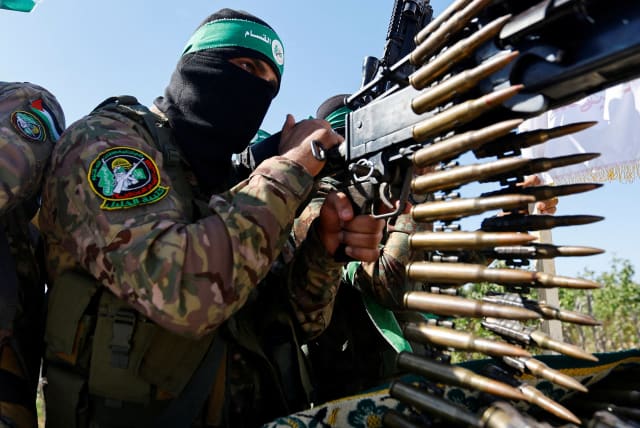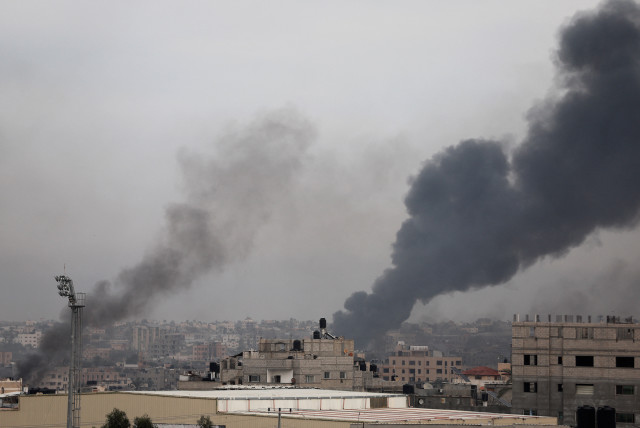The ‘Swedish Village’ in Gaza is microcosm of the tragedy of the war - analysis

When one looks at Gaza one understands that areas like this were abandoned and betrayed by the international community.
A small village in Gaza that consists of a few dozen shacks and homes near the sea and the Egyptian border is symbolic of the war in Gaza and of the disastrous history of Gaza over the last decades.
The area is called the “Swedish village,” or Al Qarya, or Suwaydiya in Arabic. On June 17, the IDF put out a video showing the small community and areas of it that were used by terrorists. The IDF distributed the video as part of a larger statement about how “soldiers of the 162nd Division have been operating in the Rafah area for about a month. The soldiers gained operational control over the Philadelphi Corridor and are targeting Hamas and its outposts in the Shabura and Tel al-Sultan areas.”
The video displayed a small village that looked like a large rectangular set of buildings near the water. One could imagine how this may actually be a nice place, hosting tourists on vacation. It had a few palm trees but otherwise, the homes had tin roofs and were mostly one story high.
In the footage, the IDF said that this area was in the operations area of the 401st Armored Brigade. The IDF video showed how some of the homes were allegedly used for terrorist infrastructure. There was a site used by Hamas for observation as well. There was also a border post called Al-Bahar, apparently being used by Hamas as well.
On June 10, Jake Godin, a senior researcher at Bellingcat, posted images on X showing an area in southern Gaza near the Egyptian border and the Mediterranean Sea. “Some new @Planet SkySat from June 9 over the Rafah area. In it, you can see that most of Al Qarya as Suwaydiya (Swedish village) has been wiped away by the IDF. IDF presence was already confirmed in the area last week when a photo was geolocated near the Egyptian border.”
Other videos of the area have surfaced. One of them depicted IDF soldiers near a war zone. This video claimed that the Swedish village was close to the site of the Peat Sadeh Jewish community near the coast that existed prior to the 2005 Disengagement from the Gaza Strip.
It appears that this small Gazan community has now been destroyed due to the current war. Back in March 2015, Middle East Eye profiled the community and noted that “the village is underdeveloped, not only because of Israel’s current blockade but because the area, even before 2005 when Hamas took over, was an isolated zone under the control of the Israeli occupation and its Jewish-only settlers, leaving the 800 Palestinian residents of the village closed in with restrictions on mobility.”
That report said that the residents of the village used to live in homes made of mud until a storm hit the area in 1965. “The village was built with the help of the Swedish and other international troops and eventually grew to contain more than 800 local residents.”
Consequently, it took on the name “Swedish.” The area came under Israeli rule after the 1967 Six Day War.
In January 2014, the Middle East Monitor also profiled the small community. “The village, which is made up of 60 families, has near non-existent infrastructure. Houses are covered with asbestos and telephone lines only reached the village a few months ago. Residents also suffer from a lack of sewage treatment facilities and a crisis in their transportation system. Residents, including school students, are forced to walk long distances and wait for long periods by the side of the road until they find a means of transportation.”
The challenges of the Swedish Village
THERE WAS a time before Hamas took over this area in 2007 when these residents had hope. In a 2005 article published in The Washington Post, which was reposted at NBC News, residents were interviewed just before Israel’s 2005 Disengagement. “From this battered town at the northern end of the Gaza Strip to a wind-blown refugee camp 24 miles away on the Egyptian border, the 1.3 million Palestinians who live in Gaza have started imagining a different life after years in the shadow of Jewish settlements and the Israeli military installations built to guard them.”
The article talked about the residents of the Swedish village who were facing difficulties at the time, needing to deal with where to send their children to get an education. In those days, they could choose from either Rafah or Al-Mawasi. They complained about the cost of sending children to school in Al-Mawasi, now the sprawling humanitarian area of Gaza.
The people of this little village also faced challenges concerning erosion. Last year, an article noted that “many years ago, village residents worried about the threat to the village posed by the sea, but few officials believed it would happen. When erosion became noticeable, the main Al-Rasheed Street, which connected the village with the rest of Gaza, nearly collapsed. In September 2015, a $29 million grant from the Qatari government reconstructed the road along with other projects.”
ONE CAN see the Swedish village as a microcosm of the conflict. Built with the support of Swedish troops who were here during the era of the Egyptian occupation, it then survived under Israeli rule from 1967 to 2005. It saw Israeli communities come and go and then Hamas rise.
One of the articles about the village in 2005 conveyed a speech by Mahmoud Abbas, the Palestinian Authority’s leader.
His rule was short and the people had no chance to enjoy any real freedom after 2005. Instead, they were plunged into new wars inflicted by Hamas. Apparently, Hamas also exploited this poorest of poor areas for terrorist purposes.
This is a symbol of what Hamas did. These people needed proper sewage and running water. They needed education programs and health care.
However, Hamas was allowed to run Gaza for fifteen years while providing nothing. The international community pretended to pick up the slack, but clearly, money that was intended for places like this was diverted to Hamas. It was stolen.
Today, the aid going to Gaza is still being diverted and stolen. Hamas did not care about these poor people. It exploited them and then disappeared and their village was destroyed due to the war. Now it is believed that the village may be paved over to make way for a road extension of the Rashid road, which runs along the coast.
When one looks at Gaza, one understands that areas like this were abandoned and betrayed by the international community. Hamas was allowed to take over and destroy Gaza, then plunge it into a war.
These people in the Swedish village never stood a chance. They had no choice over their own future, no elections, and were rapidly abandoned by the international community, which has appeared to prefer Hamas rule to a normal one that helps people and provides sewage treatment, roads, and schools.
Jerusalem Post Store
`; document.getElementById("linkPremium").innerHTML = cont; var divWithLink = document.getElementById("premium-link"); if (divWithLink !== null && divWithLink !== 'undefined') { divWithLink.style.border = "solid 1px #cb0f3e"; divWithLink.style.textAlign = "center"; divWithLink.style.marginBottom = "15px"; divWithLink.style.marginTop = "15px"; divWithLink.style.width = "100%"; divWithLink.style.backgroundColor = "#122952"; divWithLink.style.color = "#ffffff"; divWithLink.style.lineHeight = "1.5"; } } (function (v, i) { });

